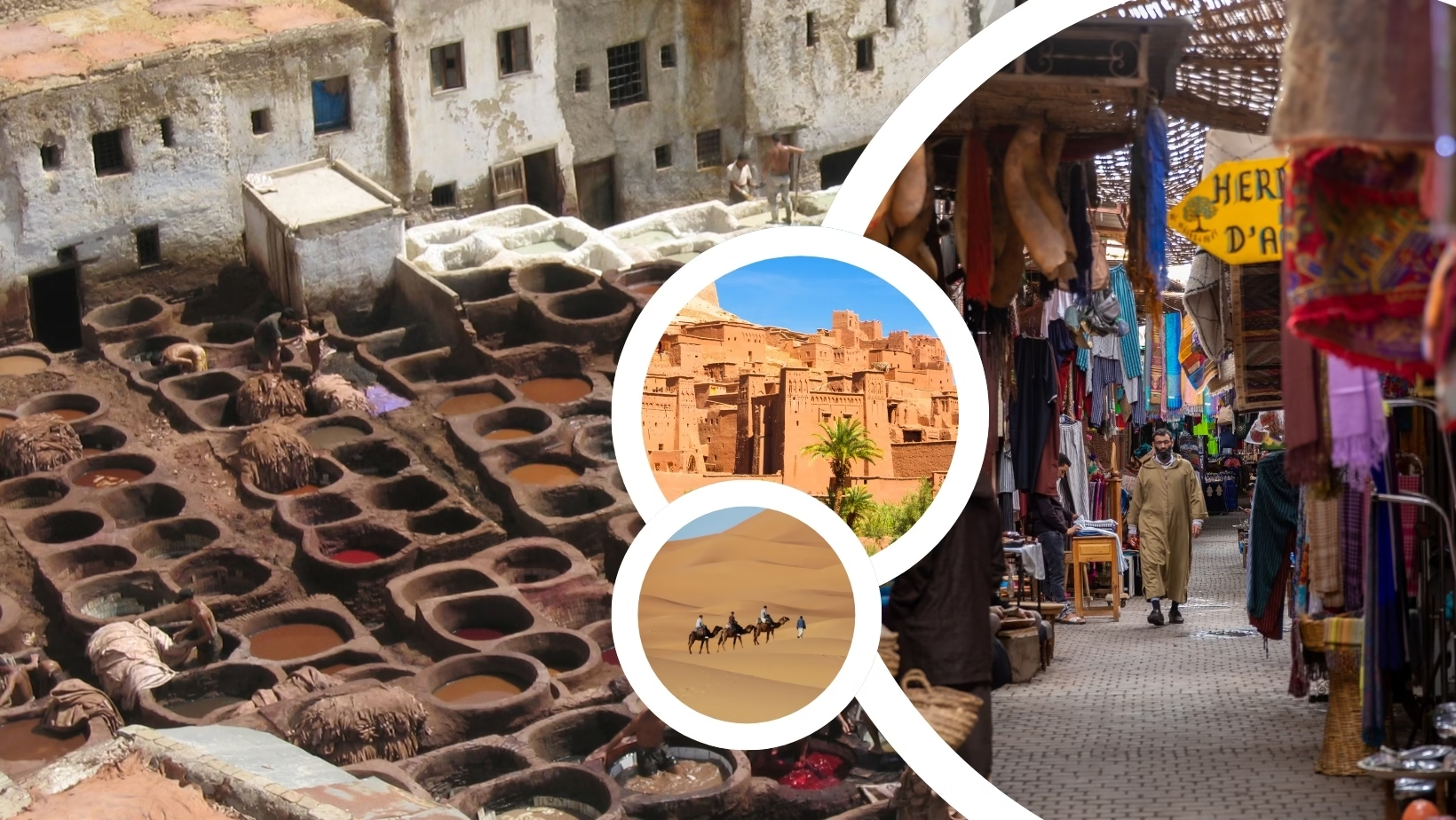Join us on an exciting 3 day desert adventure from Marrakech to Merzouga, where we’ll travel through breathtaking mountains, kasbahs, and the Sahara Desert.
We’ll cross the High Atlas Mountains and visit the famous Ait Ben Haddou, a UNESCO World Heritage site and movie location for films like Gladiator. Along the way, we’ll explore the Skoura Oasis, the Valley of Roses, and the stunning Dades Gorge, where you’ll spend our first night.
On the second day, we’ll head to the Todra Gorges, with its tall canyon walls and a peaceful river. Then, we’ll journey to Merzouga, where camels will take us across the Erg Chebbi sand dunes. you’ll watch the sunset over the Sahara, enjoy dinner at a Berber desert camp, and relax under a sky full of stars.
Wake up early for a sunrise view, have breakfast, and start our drive back through the Draa Valley and oasis towns. We’ll cross the High Atlas again before returning to Marrakech in the late afternoon or evening.

Your 3-day desert tour from Marrakech to Fes starts with a pick-up from your hotel in Marrakech. We’ll drive through the High Atlas Mountains, crossing the Tizi-n-Tichka pass (2260m), where you’ll see amazing views of valleys and Berber villages.
Our first stop is at the Ait Ben Haddou Kasbah, a UNESCO World Heritage site famous for its beautiful movie sets like Gladiator. You’ll have time to explore this old village.
After lunch near Ouarzazate, we’ll continue through the Skoura Oasis and the Valley of Roses, we head towards the impressive Dades Gorges. Here, you’ll check into your hotel/riad for dinner and overnight stay.
After breakfast, we’ll leave the Dades Valley and drive towards Tinghir, a Berber town surrounded by palm trees. This road leads us to the stunning Todra Gorges, where tall cliffs form a narrow canyon. You’ll enjoy a short walk here and take great photos.
After lunch, we’ll continue towards Erfoud, a town famous for fossils. If you like, we can visit a local workshop to see how they carve fossil marble. From there, the scenery changes as we approach the golden Erg Chebbi dunes near Merzouga.
You’ll ride a camel into the desert, stopping on top of the dunes to watch the sunset. Then, you arrive at a traditional Berber desert camp where you’ll enjoy dinner under the stars, listen to Berber music by the fire, and sleep in a cozy desert tent.
Wake up early if you want to see the sunrise over the dunes. After breakfast and a shower, we return to the edge of the desert by camel or 4×4.
We then begin our long journey back to Marrakech, taking a route through the large Draa Valley. On the way, we’ll pass towns like Rissani, Alnif, Tazarine, N’kob, and the green oasis of Agdz. We’ll stop for lunch at a nice place before continuing via Ouarzazate and crossing the High Atlas Mountains again through the Tizi n’Tichka pass.
Marrakech: Jemaa el-Fnaa, Saadian Tombs, and Majorelle Garden.
Ait Benhaddou: UNESCO-listed ksar and film locations.
Merzouga: Erg Chebbi dunes and desert camping.
Fes: Al Quaraouiyine University and Chouara Tannery.
Popular souvenirs include:
Handmade rugs and carpets
Argan oil products
Traditional pottery and ceramics
Spices and teas
Leather goods
Dress modestly, especially in rural areas and religious sites.
Ask for permission before taking photos of people.
Bargaining is expected in souks, but do so respectfully.
Greetings are important; a simple “Salam alaikum” (peace be upon you) goes a long way.
Accommodation varies depending on the destination:
Cities (Marrakech, Fes, Casablanca): Comfortable hotels or riads (traditional Moroccan houses with courtyards).
Desert (Merzouga): Overnight stays in luxury desert camps with basic amenities.
Small towns (Chefchaouen, Dades Valley): Charming guesthouses or boutique hotels.
Clothing: Lightweight, breathable clothing for daytime and warm layers for cooler desert nights. Modest attire is recommended for visiting religious sites.
Footwear: Comfortable walking shoes for exploring medinas and sturdy sandals for the desert.
Accessories: Sunscreen, sunglasses, a hat, and a scarf for protection against sun and sand.
Other essentials: A reusable water bottle, camera, power adapter, and personal toiletries.
This tour offers a blend of Morocco’s most iconic experiences:
Cultural immersion: Explore ancient medinas, UNESCO World Heritage Sites, and traditional Berber villages.
Natural wonders: From the Sahara Desert to the Atlas Mountains and lush valleys, the tour showcases Morocco’s diverse landscapes.
Historical depth: Visit historic kasbahs, ksars, and cities that have played pivotal roles in Morocco’s history.
Authentic experiences: Enjoy camel rides, desert camping, and interactions with local communities.
The best time to visit Morocco is during spring (March-May) and autumn (September-November) when the weather is mild and pleasant. Summers can be extremely hot, especially in the desert, while winters can be chilly in the mountains.
“We traveled as a family of four, and this tour was perfect for us. The itinerary was well-paced, and there was something for everyone – history in Fes, adventure in the Sahara, and relaxation in Marrakech. Our kids loved the camel trek, and my husband and I enjoyed the cultural tours and delicious Moroccan cuisine. The guides were so patient and helpful, especially with the kids. Thank you for an unforgettable family vacation!”
“I’ve traveled to many places, but this 10-day tour from Marrakech was one of the best experiences of my life. The Sahara Desert was surreal, and Fes was a cultural treasure trove. The team behind this tour is incredible – they made sure we were comfortable, informed, and having fun every step of the way. Highly recommend!”
“This tour was everything I dreamed of and more! From the vibrant streets of Marrakech to the serene blue alleys of Chefchaouen, every moment was magical. The Sahara Desert was the highlight – riding a camel into the dunes and spending the night under the stars was unforgettable. The guides were fantastic, and the accommodations were top-notch. Highly recommend!”
